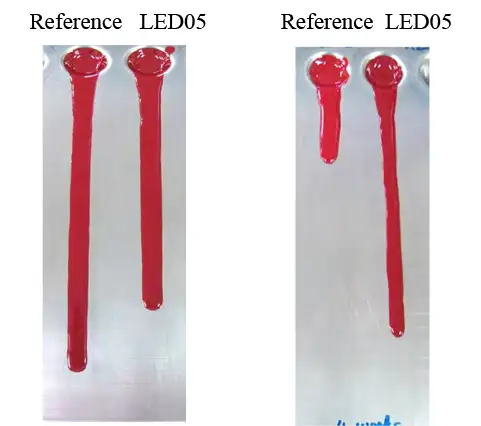By Tong Wang, Ph.D., allnex USA Inc.; Steven Cappelle, Ph.D., allnex Belgium; and Paul Gevaert, Ph.D., allnex Belgium
Poor surface cure due to oxygen inhibition presents a consistent challenge in LED curing. Amine synergists can provide abstractable hydrogen to mitigate oxygen inhibition and improve surface cure. Three amino acrylates are evaluated as LED boosters to improve the surface cure by LED. EBECRYL LED03 (hereafter: LED03) is targeting for Overprint varnishes (OPVs), flexo or inkjet inks. It has low viscosity and can improve surface cure speed with less photoinitiator usage. EBECRYL LED04 (hereafter: LED04) is designed specifically for litho inks. It can improve surface reactivity and has little negative impact on ink-water balance. EBECRYL LED05 (hereafter: LED05) is suitable for flexo inks, which can maintain good ink stability. They are all Nestlé/Swiss compliant and have low-migration features.
Introduction
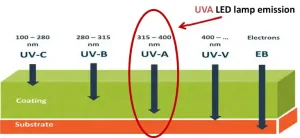
UV LED cure is becoming a trend in the UV coating industries because it offers several advantages, such as instant on and off, long lifetime of lamp, less heat generation and no ozone production.6 The biggest challenge associated with LED is poor surface cure, which is caused by oxygen inhibition. The coating surface is exposed to air, which contains 21% oxygen. Oxygen molecules can quench the triplet state of the photoinitiators or scavenge the carbon-based free radicals to become unreactive peroxy radicals to slow down the polymerization.4
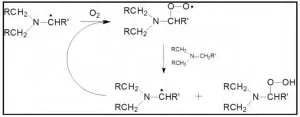
Oxygen inhibition is more severe in LED cure because LED doesn’t emit short wavelengths of UV. As illustrated in Figure 1, there is a wavelength dependence on absorption of UV. UV-curable materials usually have a higher absorbance to short wavelength energy (UVC) than to longer wavelength energy (UVB and UVA), affecting the depth of cure. Short wavelength energy does not penetrate much beyond the surface, and longer wavelength energy survives to penetrate deeper into the coating. The typical wavelengths of LED are 365, 385, 395 and 405 nm, which are located in the UVA range. The lack of short wavelength of LED results in increased oxygen inhibition at the surface of the coating. In addition, the low power output of some LED lamps cannot deliver sufficient energy to the surface to generate enough free radicals to mitigate oxygen inhibition. All of these factors magnify the negative impact of oxygen inhibition and can result in tacky and uncured surfaces.
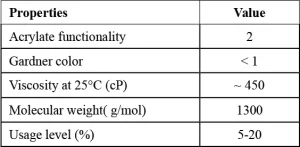
There are known physical and chemical approaches to overcome oxygen inhibition to improve surface cure.1 The use of amino acrylates is one of the most commonly implemented solutions. The hydrogens on the carbon atoms’ alpha to nitrogen easily are abstractable, and there are many of these in each molecule. Those abstractable hydrogen atoms can react with peroxy radicals as illustrated in Figure 2. The acrylate functionality also ensures that the materials can be built into an acrylate network and reduce the risk of migration. In this paper, three amino acrylates will be evaluated for their capability to reduce oxygen inhibition and increase surface cure. Their characteristics and applications in OPVs, flexo inks and litho inks will be discussed.
LED03 for OPV and flexo ink applications

LED03 is an amino diacrylate suitable for OPVs, flexo and inkjet ink applications. The characteristics of LED03 are given in Table 1. It has low color, odor and viscosity. Because LED03 is a low-migration product and complies with Nestlé/Swiss lists3, it is suitable for food packaging. Typically, 5 to 20% of LED03 is used in the formulation.
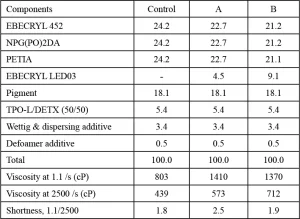
Several OPV formulations with different photoinitiators were prepared to achieve similar viscosity, according to Table 2. 15% LED 03 was added into some formulations. The formulations were further coated onto a black and white Leneta chart to achieve ~ 5 µm coating thickness. The coating was cured under 395 nm LED at 70 fpm (energy density around 760 mJ/cm2). The distance between the lamp and the substrate was 1 cm. The surface cure was determined by gently swiping a wood stick across coating surface to observe any presence of mar. The yellowing index was reported as the Δb value measured with a BYK Spectroguide Sphere.
With addition of 15% of LED03, the results indicate the amount of photoinitiator can be reduced without impacting cure speed. Lower color of coating also is observed with less photoinitiator usage. Photoinitiator reduction offers advantages, such as lower cost of the total formulation, decreased coating color, minimized risk of photoinitiator migration, etc.
Flexo inks were prepared according to Table 3. Five or 10% LED03 was added into the ink formulations. The ink viscosity was measured at low (1 /s) and high (2500 /s) shear rates. The shortness index was determined by the ratio of the viscosity at low to high shear rate. For a truly Newtonian fluid, this value should be equal to one as the viscosity of a Newtonian fluid is independent of shear rate. Logically, the closer the shortness index is to one, the more Newtonian the ink. The closer a flexo ink is to Newtonian, the better it will perform on press. All three ink formulations have similar shortness index values, which indicates incorporation of LED03 doesn’t change ink rheology.
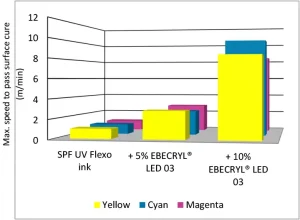
Three colors of ink formulations (cyan, yellow and magenta) were prepared, applied to the substrate and cured under 395 nm LED. The surface reactivity was evaluated by graphite method. A small amount of graphite powder was deposited on the cured ink surface and then wiped by cotton ball. If there was no graphite residual after wiping, it indicated good surface cure was achieved. The maximum speed to pass graphite testing thus was determined. As demonstrated in Figure 3, the surface reactivity is improved with the addition of LED03 for each color. Higher surface reactivity is achieved when a higher level of LED03 is used.
LED 04 for litho ink application

Aminobenzoates, such as Ethyl-4-(dimethylamino)benzoate (EDB), have been used in litho inks because they are more reactive than simple tertiary amines and exhibit less “bloom.” EDB is hydrophobic so it is suitable for litho applications where ink-water balance is critical. However, EDB is reclassified to be reprotoxic 1B under REACH registration. LED04 is developed to be an alternative to replace EDB. LED 04 has acrylate functionality of 6 and can be crosslinked into the network. LED 04 is a Nestlé/Swiss-compliant and low-migration product. Table 4 summarizes the features of EDB, LED04 and another reference polymeric amino benzoate product.
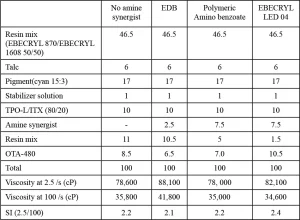
The litho ink formulations were prepared based on Table 5. EDB, reference polymeric amino benzoate and LED04 were added into the formulations based on their amine content. Their viscosities were measured at low or high shear rates and the shortness index was determined. All four inks have similar low shortness indices, which suggests the addition of an amine synergist has little impact on ink rheology. The inks were printed on the substrate and cured by Hg, 395 nm or 365 nm LED lamps. The maximum speed to achieve surface cure was determined (Figure 4). The surface cure speed is improved significantly with the addition of an amine synergist for both Hg and LED cure. When incorporating polymeric amino benzoate or LED04 into the ink formulations, the surface cure speed is further improved compared to the one with EDB.
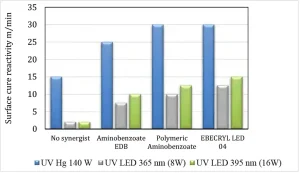
Ink-water balance of a litho ink is critical to achieve good print quality. If the ink is too hydrophilic, it picks up more water and gets to non-image areas of the printing plate. The print can lose optical density and dot gain (tonal value). On the other hand, if the ink is too hydrophobic, the emulsification doesn’t happen, which results in uneven, mottled ink. An ink is required to have good ink-water balance so it can be emulsified with water to form a fine and stable emulsion, which then can be transferred to blanket and further printed on the substrate.2 Hydroscope – a technique to monitor the tack as function of emulsification – is a useful tool to characterize the ink-water balance. When water is metered to an ink at a constant speed, the tack value of the ink is monitored with time. When the ink first contacts with water, the tack value gradually would drop and reach a plateau with more water. When water stops, the tack value would recover back to its original level.
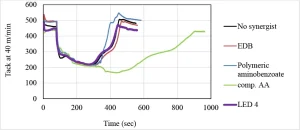
Figure 6 presents the hydroscope results of several litho inks. To demonstrate the influence of amino acrylate on ink-water balance, a comparative amino acrylate (comp AA) is included. Compared to the control (no amine synergist), the tack values of all inks except the comparative amino acrylate drop to the same plateau level and recover back similarly. This indicates the addition of EDB, reference polymeric aminobenzaoate or LED04 doesn’t cause negative impact on ink-water balance. On the other hand, the ink with comparative amino acrylate behaves differently. It reaches the lower plateau level and recovers much slower than others. This comparative amino acrylate is more hydrophilic, which causes the ink to absorb more water and has poor ink-water balance. Emulsification point also can be determined by hydroscope testing. Figure 7 shows the emulsification point for different inks. The ink with comparative amino acrylate has a higher emulsification point value than others.
LED05 for flexo ink
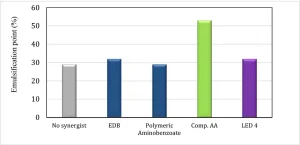
Ink stability is important, especially for flexo ink, because it usually has low viscosity. Some amine synergists can cause the ink viscosity to increase significantly with time. It is speculated some interactions can happen between amine group and surface treatment of pigment used in the ink. LED05 is designed for flexo ink to maintain good ink stability. It is an amino acrylate with functionality of 6 and has medium viscosity. It has low migration features. The properties of LED05 are given in Table 6.
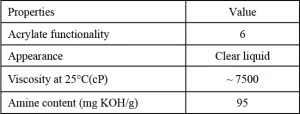
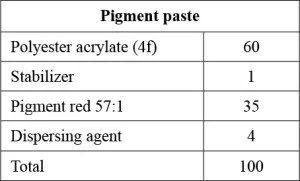
The flexo ink with 10% LED05 was prepared based on Table 7 and 8. For comparison, another ink with the same level of a reference amino acrylate also was included. The viscosities of those two inks at low (2.5 /s) or high (2500 /s) shear rate were measured with time. The shortness index was calculated as previously described. Figure 8 exhibits the ink with LED05 can maintain its initial shortness index over time while another ink with reference amino acrylate increases dramatically. Figure 9 shows the ink flow on a flow plate. At the beginning, the reference ink flows slightly better than the ink with LED05. After four-week storage, the opposite trend is observed.
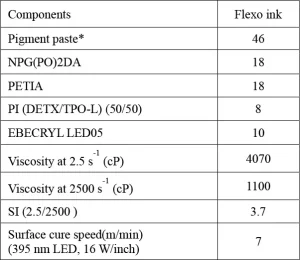
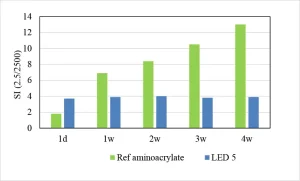
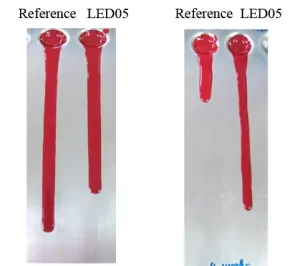
Conclusion
Three amino acrylates have been evaluated for various applications. LED03 is suitable for OPVs, flexo and inkjet inks. It can improve the surface cure of OPVs with less photoinitiator usage. It can increase surface reactivity when used in flexo inks. LED04 is designed for litho inks because of its hydrophobicity nature. It can achieve higher surface cure speed while maintaining good ink-water balance. LED05 has advantages in maintaining good ink stability when used in flexo ink. All three amino acrylates are Nestlé/Swiss compliant and have low migration features.
References
- Branislav Husár, Progress in organic coatings, 2014(77), 1789-1798
- Naruchart Boonkuernoon, “A study to determine the relationship between emulsification and tack of offset lithographic ink”, MS thesis, 1994
- Nestlé Guidance Note on Packaging Inks
- Katia Studer, Progress in Organic Coatings 2003(48), 92–100
- Jo Ann Arceneaux, Radtech conference proceedings, 2014
- Thomas R. Mawby, Radtech conference proceedings, 2014



